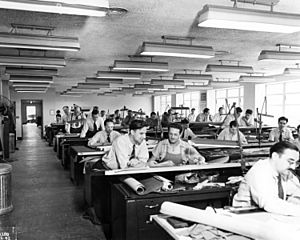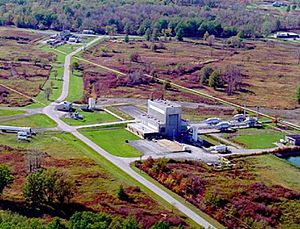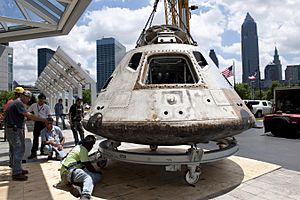Glenn Research Center facts for kids
 |
|
 Aerial view of Glenn Research Center at Lewis Field |
|
| Agency overview | |
|---|---|
| Formed | 1942 |
| Preceding agencies |
|
| Jurisdiction | Federal government of the United States |
| Headquarters | Brook Park, Ohio, U.S. 41°24′46″N 81°51′45″W / 41.412843°N 81.862399°W |
| Agency executive |
|
| Parent agency | NASA |
| Child agency |
|
The NASA John H. Glenn Research Center at Lewis Field is a special place where NASA scientists and engineers work. It is located in Ohio, near the city of Cleveland. This center is one of ten main NASA facilities. Its most important job is to create new science and technology. This new tech helps us explore space and improve airplanes.
As of 2012, about 1,650 government workers and 1,850 support staff worked there. In 2010, the NASA Visitors Center, which used to be at the site, moved. It is now part of the Great Lakes Science Center in downtown Cleveland. This made it easier for more people to visit and learn about NASA's work.
Contents
History of the Glenn Research Center
The center started in 1942. It was part of a group called the National Advisory Committee for Aeronautics (NACA). Later, it became part of NASA. Its first job was to research aircraft engines.
It was first called the Aircraft Engine Research Laboratory. This name was approved in June 1940. Over the years, its name changed a few times. In 1947, it became the Flight Propulsion Research Laboratory. Then, in 1948, it was named the Lewis Flight Propulsion Laboratory. This honored George W. Lewis, who led NACA for many years. When NASA was created in 1958, it became the NASA Lewis Research Center.
On March 1, 1999, the center got its current name. It was renamed the NASA John H. Glenn Research Center at Lewis Field. This was to honor John Glenn. He was a famous fighter pilot and the first American astronaut to orbit Earth. He also became a politician.
As early as 1951, researchers at the center were already studying how liquid rocket engines burn fuel.
Amazing Facilities at Glenn
Neil A. Armstrong Test Facility
The Neil A. Armstrong Test Facility is a huge part of the Glenn Research Center. It covers about 6,400 acres near Sandusky, Ohio. This facility is about 50 miles away from the main campus. It is used for very large tests that might be too dangerous to do at the main site.
As of 2015, this station had five main testing areas:
- B-2 Spacecraft Propulsion Research Facility
- Combined Effects Chamber
- Cryogenic Components Laboratory (which was planned to be taken down)
- Hypersonic Test Facility
- Space Power Facility
In 2019, two U.S. senators from Ohio suggested renaming the facility. They wanted to honor Neil Armstrong, the first person to walk on the Moon. This idea became a law on December 30, 2020. So, the Plum Brook Station was officially renamed the Neil A. Armstrong Test Facility.
B-2 Spacecraft Propulsion Research Facility
The B-2 Spacecraft Propulsion Research Facility is unique. It is the only place in the world that can test large rocket parts. It can test full-size upper-stage rockets and engines. It does this under conditions that are like high-altitude space. The Space Power Facility here has the world's largest vacuum chamber for space environments.
Icing Research Tunnel
The Icing Research Tunnel is a special wind tunnel. It can create conditions like ice forming in the atmosphere. Scientists use it to see how ice builds up on airplane wings and bodies. They also test systems that prevent ice from forming on aircraft.
Zero Gravity Research Facility
The Zero Gravity Research Facility is a very deep vertical vacuum chamber. It is used to drop experiments to test them in microgravity. Microgravity is like being weightless. This facility helps scientists study how things like parts, systems, liquids, and gases behave when they are weightless.
The facility has a concrete shaft that is 28 feet wide. It goes down 510 feet below the ground. Inside, there is an aluminum vacuum chamber. It is 20 feet wide and 470 feet tall. Before an experiment, the air is sucked out to create a vacuum.
There is also a smaller drop tower at the facility. It allows experiments to fall for 2.2 seconds. This smaller tower is used for educational programs. These programs are called Dropping in a Microgravity Environment (DIME) and What if No Gravity (WING).
This facility was recognized as a National Historic Landmark in 1985. It has been the largest microgravity facility in the world since 2003.
Key Developments and Discoveries
Aeronautics Science and Technology
NASA Glenn works on improving jet engines. They create designs that use less energy, cause less pollution, and make less noise. For example, they developed special shapes called "chevrons" to reduce noise. You can see these chevrons on many commercial jet engines today, including those on the Boeing 787 Dreamliner.
Space Science and Technology
The Glenn Research Center and its partners have made many important contributions to space exploration:
- They developed the liquid hydrogen rocket engine. This engine was very important for the Apollo Moon landings.
- They helped create the Centaur upper-stage rocket.
- They invented the gridded ion thruster. This is a very efficient engine for space travel. A Glenn-developed ion engine was used on the NASA probe Deep Space 1.
- They designed the Electrical Power System for the Space Station Freedom. A slightly changed version is now used on the International Space Station.
- They developed the Universal Stage Adapter for the planned Block 1B version of the Space Launch System (SLS).
How Glenn Helps Others
Education and Internships
The Glenn Research Center has a program called the Lewis' Educational and Research Collaborative Internship Program (LERCIP). This program offers internships to high school and college students. It also helps high school teachers.
The high school program is an eight-week internship. It is for students in their sophomore and junior years. It is for those interested in science, technology, engineering, math, or office work. The college program lasts 10 weeks. It is open to college students at any level. High school LERCIP is for students in the Cleveland area. However, college LERCIP is open to students from all over the country. Interns work closely with NASA experts. They are involved in the center's daily activities. They are expected to work 40 hours a week during their internship. The LERCIP Teacher program is a 10-week internship for teachers in STEM fields.
Other Educational Programs
The Dropping In Microgravity Environment (DIME) is an annual contest. High school student teams write ideas for experiments. These experiments are then performed in the Drop Tower. The winning teams get to visit the center. They perform their experiments and write a report for NASA.
The Future of Glenn Research Center
After 2004, NASA started focusing more on space exploration. This was part of a plan called the Vision for Space Exploration. Some people thought that research centers like Glenn might become less important. However, in May 2006, it was announced that NASA Glenn would manage the service module for the Crew Exploration Vehicle. This work brought many jobs and funding to the center. It showed that the center's focus was shifting from airplane research to space exploration. This new direction matched NASA's overall mission.
In 2010, there was another change in direction. President Obama and Congress decided to end the Vision for Space Exploration. They wanted to find a new path for human spaceflight and NASA. However, the 2015 budget for NASA increased funding for projects that the Research Center works on. These included aeronautics research, planetary science, and space technology. Some of this funding was expected to go to the Glenn Research Center.
NASA Glenn Visitor Center
In September 2009, the Glenn Research Center closed its own Visitor Center. Many of its exhibits were moved to the Great Lakes Science Center. This move was done to save money on public relations. It also made it easier for the public to visit. By putting the exhibits at the more popular science center, NASA Glenn got more attention. The new Glenn Visitor Center section at the Great Lakes Science Center attracted 330,000 visitors in its first year. This was much more than the 60,000 visitors per year at the old site.
The NASA Glenn Research Center also offers public tours of its research facilities. These tours happen on the first Saturday of each month. You need to make reservations ahead of time to join a tour.
Images for kids
See also
 In Spanish: Centro de investigación Glenn para niños
In Spanish: Centro de investigación Glenn para niños


















